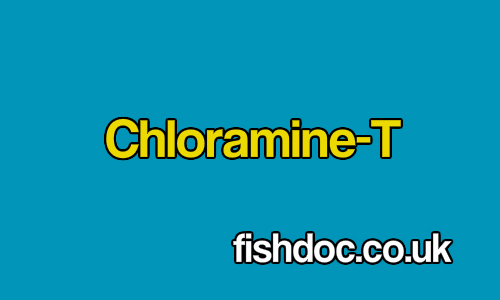Chloramine-T and fish disease.As chloramine-T dissolves it slowly breaks down to produce hypochlorous acid (HOCl), which in turn releases chlorine and oxygen. There is some uncertainty as to the active species of the breakdown products. Certainly, any chlorine present is liable to have an effect against flukes and parasites such as Costia, Chilodonella, white spot and Trichodina, as well as bacteria. However, it is now believed that the chloramine-T ion is the major active species. It breaks down fairly rapidly and treatments can be repeated on a daily basis without the need for major water changes. As with most treatments, it is advisable to by-pass the filter during treatments, although nitrifying bacteria seem to be fairly tolerant of of this treatment. However it is a wise precaution to turn the filter off for 3-4 hours while treatments are in progress. Affected by water hardness and pH The toxicity of chloramine-T is affected by the pH and hardness of water, being more toxic in soft, acidic water. Therefore it is important to check these parameters before use. The table below shows typical dose rates at various pH and hardness
How effective is it? My own experience of pond treatments (usually doses <5mg /litre in hard, alkaline water) are varied and often disappointing. Follow-up examinations often show targeted parasites such as Trichodina and flukes are still present in substantial numbers after treatment. The usually recommended dose rate for ponds is given as 2mg/litre by most aquatic sources. I have serious doubts as to the efficacy of this dosing level in the typical hard alkaline water found in southern England. Controlled treatments in clean, bare treatment tanks using doses of 10-16mg/ litre have shown more promise, having an effect against Gyrodactylus (skin flukes) and Dactylogyrus (gill flukes). This regime works well against Costia, but not quite as well against Trichodina. These trials were only started last year and more data is needed complete the picture. This page will be updated as more tests are carried out. My initial conclusions are that it is probably better suited for tank treatments rather than pond treatment as conditions and dosages can be better controlled. In the case of the pond treatments, more investigation needs to be carried out to determine an effective dose that allows for the effects of hard water and organic pollution. It is likely that current pond dosage rates of < 5mg/litre, particularly in hard, alkaline pond water, need to be increased to > 10 mg/litre and a follow up examination carried to determine the effectiveness of the treatment, with a view to re-dosing as necessary. Any thoughts – put them on the Fishtalk forum and we can all join in! More on chloramine-T
See the fish disease section for more details about specific parasites or diseases
|
|||||||||||||||||||||||||||||||||||||||

